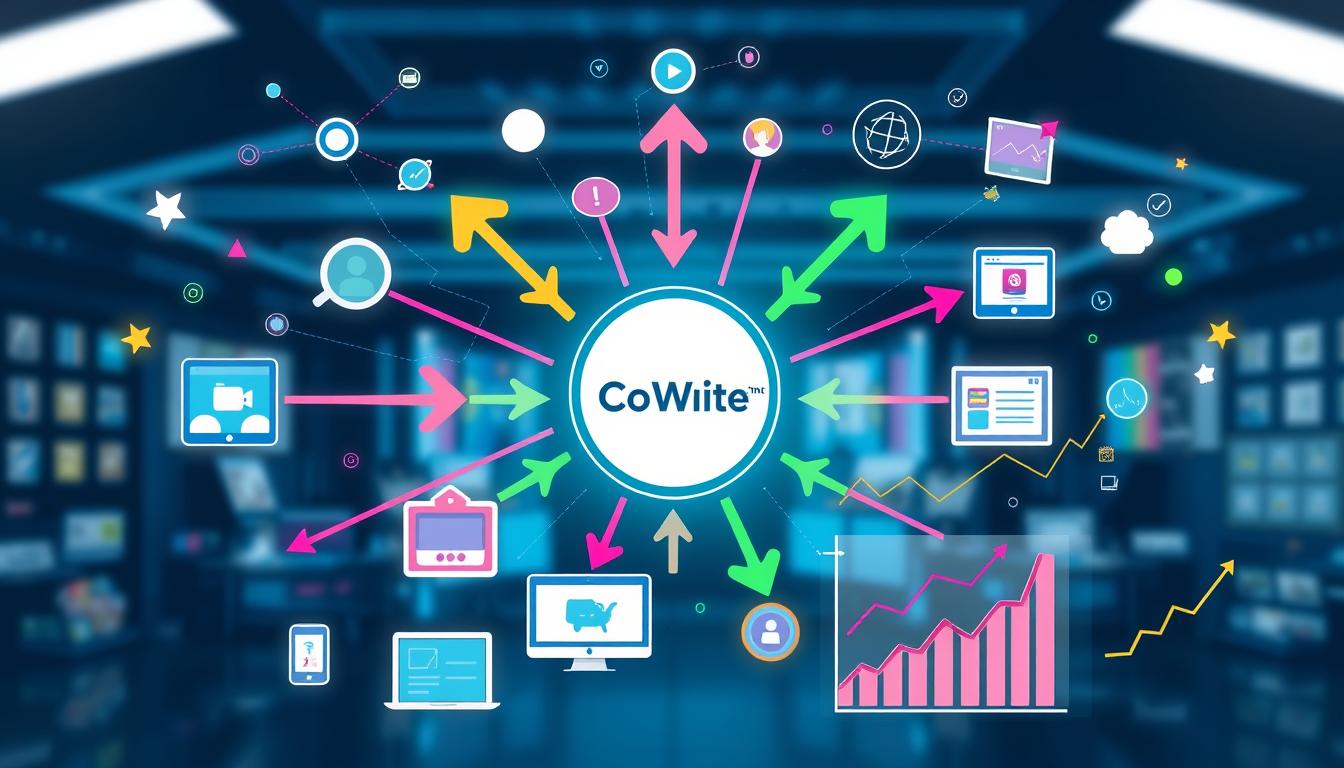Affiliate marketing is now a big deal in the digital world. Brands are spending a lot on partnerships in 2025. This makes it a great way to earn passive income and grow your online business.
You can make a steady income by working with well-known brands. Promote their products or services to your followers. With digital marketing getting bigger, it’s key to keep up and find new chances. Need help? Talk to experienced content writers who know affiliate marketing well.
Key Takeaways
- Understand the concept of affiliate marketing and its growing importance.
- Learn how to leverage affiliate marketing to boost your online business.
- Discover ways to create a steady stream of passive income.
- Explore the benefits of partnering with reputable brands.
- Stay ahead of the curve in digital marketing trends.
Understanding Affiliate Marketing: Key Concepts
Affiliate marketing is a great way to earn money online. It’s a strategy where you promote products and earn commissions. This method has changed how businesses grow online.
What is Affiliate Marketing?
Affiliate marketing lets you promote products and earn money. You share products and get a commission when someone buys through your link. It’s a simple way to make money online by promoting products you like.
This method is easy and can make you money without creating products. You just connect people with what they need.
How Does Affiliate Marketing Work?
Affiliate marketing involves several roles: the merchant, the affiliate network, and you. Here’s how it works:
- You join an affiliate program through a network.
- You get a unique link to track your referrals.
- You share products with your audience.
- You earn a commission when someone buys through your link.
Affiliate marketing has three types. Unattached marketing promotes products without a direct connection. Related marketing promotes products relevant to your audience. Involved marketing promotes products you’ve used and trust.
Benefits of Affiliate Marketing for Entrepreneurs
Affiliate marketing is great for entrepreneurs. It offers several benefits:
| Benefit | Description |
|---|---|
| Low Risk | It’s low-risk because you don’t invest in product development. |
| Passive Income | It can generate passive income through commissions. |
| Flexibility | You can work from anywhere and at any time. |
| Minimal Startup Costs | Starting costs are low. |
Understanding these concepts helps you create effective affiliate marketing strategies. It’s a good way to grow your online business. Whether you’re new or experienced, affiliate marketing can help you reach your goals.
The Growth of Affiliate Marketing in 2025
As we enter 2025, affiliate marketing is set to grow a lot. This growth comes from new trends and tech. The field is changing with new strategies, how people shop, and digital marketing advances.
Trends Driving Affiliate Marketing Success
Several trends are making affiliate marketing successful in 2025. These include AI and automation, influencer marketing, and content personalization.
- AI and Automation: Affiliate marketers use AI to analyze data, improve campaigns, and create better content.
- Influencer Marketing: Working with influencers is key to reaching specific audiences.
- Content Personalization: Making content for each person improves the user experience and boosts sales.
To keep up, understanding and adapting to these trends is vital. For example, AI tools can predict what people want and help improve marketing plans.
Popular Niches to Explore
Affiliate marketers are looking into different niches for good opportunities. Some top niches for 2025 are:
| Niche | Potential | Key Products/Services |
|---|---|---|
| Health and Wellness | High | Fitness programs, nutritional supplements |
| Technology and Gadgets | Very High | Latest gadgets, software solutions |
| Sustainable Living | Moderate to High | Eco-friendly products, renewable energy solutions |
These niches offer many chances for affiliate marketers to promote products that appeal to their audience.
By knowing the trends and exploring popular niches, you can create strong strategies. This will help your online business grow a lot in 2025.
Choosing the Right Affiliate Programs
Finding the right affiliate programs is key to making money online. With many choices, it’s important to pick wisely. Look for programs that match your business goals.
Factors to Consider When Selecting Programs
When picking an affiliate program, consider a few things. Look at the commission rates, how long the cookie lasts, and the quality of what’s being sold. A high commission rate but short cookie might not be as good as a lower rate with a longer cookie.
“The best affiliate programs offer a balance between competitive commissions and high-quality products that resonate with their audience,” says industry expert, John Doe. He stresses the importance of matching what you promote with what your audience wants.
- Commission rates: Look for programs that offer competitive rates.
- Cookie durations: Longer durations increase the chances of earning commissions.
- Product quality: Promote products that are relevant and valuable to your audience.

Top Affiliate Programs for 2025
For 2025, some top affiliate programs are known for their success in affiliate marketing. They offer good commissions and strong support and tracking tools.
“The future of affiliate marketing is bright, with innovative programs emerging to meet the evolving needs of online businesses,” notes Jane Smith, a leading affiliate marketer.
By carefully looking at these factors and choosing the right programs, you can boost your affiliate marketing success. This will help you earn passive income.
| Program Name | Commission Rate | Cookie Duration |
|---|---|---|
| Program A | 8% | 30 days |
| Program B | 10% | 60 days |
Building Your Online Presence
To succeed in affiliate marketing, having a strong online presence is key. It’s the base of your affiliate marketing work. It also affects your Online Business Growth.
Creating a Website or Blog for Affiliate Marketing
Setting up a website or blog is a big step. It’s where you share valuable content, promote products, and connect with your audience. Here are some tips for your website or blog:
- Choose a niche-specific domain name to enhance credibility.
- Opt for a user-friendly Content Management System (CMS) like WordPress.
- Select a responsive theme that adapts to various devices.
- Ensure your site is secure with HTTPS encryption.
For more insights on affiliate marketing strategies, you can visit this resource to stay updated on the latest trends.
Leveraging Social Media for Promotion
Social media platforms are great for promoting your affiliate links and reaching more people. To use social media well:
- Identify the platforms where your target audience is most active.
- Create engaging content that resonates with your audience.
- Use paid advertising options to boost your visibility.
- Interact with your followers to build a loyal community.

Importance of SEO in Affiliate Marketing
SEO is vital for making your website more visible on search engines. It brings organic traffic to your site. Key SEO practices include:
- Conducting thorough keyword research to identify relevant terms.
- Optimizing your content with appropriate meta tags and headings.
- Creating high-quality, engaging content that adds value.
- Building backlinks from reputable sites to enhance your site’s authority.
Knowing and using these SEO strategies can greatly improve your Affiliate Marketing in Online Business efforts.
| SEO Strategy | Description | Benefit |
|---|---|---|
| Keyword Research | Identifying relevant keywords for content optimization. | Improved search engine ranking. |
| Content Optimization | Using meta tags, headings, and quality content. | Enhanced visibility and user engagement. |
| Backlink Building | Acquiring links from authoritative sites. | Increased site authority and trust. |
Content Creation Strategies for Affiliate Marketing
To make money online through affiliate marketing, focus on your content. High-quality, engaging content drives sales and boosts earnings. We’ll look at the best content types and how to write reviews that connect with your audience.
Types of Content That Drive Sales
To succeed in affiliate marketing, create content that draws in your audience. Some top content types include:
- Product reviews: Detailed, honest reviews of products or services.
- Tutorials and guides: Step-by-step instructions on how to use a product or service.
- Comparisons: Comparing different products or services to help buyers decide.
- Listicles: Lists of top products or services in a niche.
A study found that 85% of consumers trust online reviews as much as personal recommendations (BrightLocal, 2023). This shows how important trustworthy content is.

Writing Honest and Persuasive Reviews
When writing reviews, honesty is key. Your audience must trust your recommendations. Make sure to:
- Disclose any affiliations with the product or service provider.
- Highlight both the pros and cons of the product or service.
- Use personal anecdotes or experiences to make the review more relatable.
Pat Flynn, a well-known affiliate marketer, said,
“The key to success in affiliate marketing is to be authentic and transparent with your audience.”
This honesty builds trust and drives sales.
| Content Type | Purpose | Benefits |
|---|---|---|
| Product Reviews | To review and compare products | Builds trust, drives sales |
| Tutorials and Guides | To educate on product usage | Establishes authority, increases engagement |
| Comparisons | To compare products or services | Helps in decision-making, drives conversions |
By using these content strategies, you’ll be on your way to success in affiliate marketing.
Techniques to Drive Traffic to Your Affiliate Links
Getting people to visit your affiliate links is key to making money through affiliate marketing in 2025. You need to use a mix of good techniques. These should bring in the right kind of traffic that matches your products.
Utilizing Email Marketing
Email marketing is a top way to get people to your affiliate links. Build an email list and send out interesting content. This way, you can share your affiliate products with people who might actually be interested.
To start, make sure your content is valuable and speaks to your subscribers. Use email tools to make your messages more personal and automated.
Some email marketing tips include:
- Segmenting your email list to tailor your messages
- Using attention-grabbing subject lines to improve open rates
- Including clear calls-to-action (CTAs) to drive traffic to your affiliate links
Paid Advertising Options
Paid ads are also great for getting people to your affiliate links. Sites like Google Ads and Facebook Ads let you target specific groups. This means your ads will reach the right people.
It’s important to keep an eye on how your ads are doing. Adjust your strategies to get the best return on investment.
Here’s a look at some popular paid ad platforms:
| Platform | Targeting Options | Cost |
|---|---|---|
| Google Ads | Keyword, location, device | Cost-per-click (CPC) |
| Facebook Ads | Demographics, interests, behaviors | Cost-per-impression (CPM) or CPC |
Social Media Marketing Tactics
Social media is a big part of getting people to your affiliate links. Make interesting content and pick the right platforms. This way, you can reach lots of people and get them to check out your products.
Key social media marketing tactics include:
- Creating high-quality, engaging content that resonates with your audience
- Using relevant hashtags to increase your reach
- Engaging with your followers to build trust and credibility

By using email marketing, paid ads, and social media, you can build a strong plan. This plan will help you drive traffic to your affiliate links and make money through affiliate marketing in 2025.
Measuring Your Affiliate Marketing Success
It’s key to know how to measure your affiliate marketing success. This helps you make smart choices and grow. You need to track and analyze different metrics to see how well your campaigns are doing.
Key Performance Indicators to Track
Focus on important metrics like click-through rates (CTR), conversion rates, and earnings per click (EPC). CTR shows how often people click on your links. Conversion rates tell you how many clicks lead to sales or actions. EPC is about the average earnings per click.
Other key metrics include:
- Conversion Rate: The percentage of visitors who take a desired action.
- Earnings Per Click (EPC): The average earnings per click.
- Return on Investment (ROI): The profit from your affiliate marketing efforts.
- Customer Lifetime Value (CLV): The total value a customer brings over their lifetime.
As Patagonia’s marketing director once said, “Understanding your customer and providing value is key.” Tracking these metrics helps you know your audience better and improve your strategies.
Tools for Analyzing Performance
Many tools can help you analyze your affiliate marketing performance. Google Analytics is a powerful tool that gives insights into website traffic, engagement, and conversion rates. It shows which affiliate links work best and which need work.
Other tools include:
- Affiliate network dashboards: Most networks offer detailed reports on clicks, conversions, and earnings.
- Tracking software: Tools like ClickMagick or Voluum track your affiliate link performance across campaigns.
- SEO tools: Tools like Ahrefs or SEMrush analyze your SEO performance, important for organic traffic.
“The key is not to prioritize what’s on your schedule, but to schedule your priorities.” – Stephen Covey
By focusing on tracking your KPIs and using the right tools, you can improve your affiliate marketing. Need expert content writers? Reach out on WhatsApp: +44-7822-010953 | +44-7874-424345.

Challenges in Affiliate Marketing
Affiliate marketing offers a chance for passive income but comes with challenges. These include fierce competition and technical problems. Knowing these obstacles and how to tackle them is key for your online business to thrive.
Common Mistakes to Avoid
Affiliate marketers often stumble into avoidable pitfalls. One big mistake is picking the wrong affiliate programs. To sidestep this, research the program’s reputation and make sure it fits your niche.
- Failing to disclose affiliate links properly
- Promoting too many products, diluting your focus
- Not tracking performance metrics effectively
Another major blunder is not diversifying your income sources. Relying on just one affiliate program or product can be risky. If the program changes its terms or the product is no longer available, you could face big losses.
How to Overcome Setbacks
To beat setbacks in affiliate marketing, you need to be proactive. First, stay updated with industry trends and tweak your plans as needed. This could mean attending webinars, following industry leaders, or joining relevant forums.
| Challenge | Strategy to Overcome |
|---|---|
| Intense Competition | Differentiate your content and offer unique value |
| Technical Issues | Regularly update your website and ensure reliable hosting |
| Changes in Consumer Behavior | Stay informed about market trends and adjust your content strategy |
By grasping these challenges and using strategies to conquer them, you can boost your online business. If you need help, consider reaching out to experienced pros. They can guide you through these hurdles and help you succeed in affiliate marketing.
The Future of Affiliate Marketing Beyond 2025
Looking ahead, affiliate marketing will see big changes. Innovations like artificial intelligence and influencer marketing will play big roles. With affiliate marketing spending expected to hit $12 billion, staying ahead is key.
Emerging Trends and Technologies
AI will change how you make content and analyze data. This means more personalized and effective campaigns. Social commerce on sites like Instagram and Pinterest will also grow, opening new doors for affiliate marketers.
Adapting to Changing Consumer Behaviors
To keep up, you must adapt to new consumer habits. This means using different commission models and keeping up with digital marketing trends. By doing this, you’ll be ready to succeed in affiliate marketing and reach your earning goals, no matter your level of experience.



